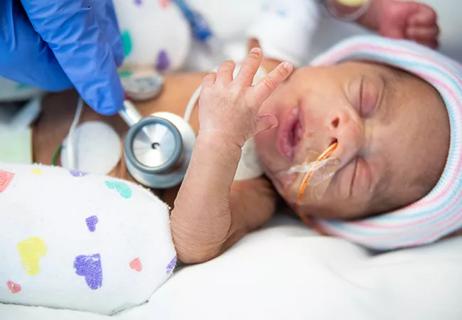Advertisement
Feasibility study suggests telemedicine platform is useful for families, regardless of gestational age at birth

Telemedicine is a feasible platform for follow-up after discharge from the neonatal intensive care unit (NICU), and may ease the transition of the infant into the home, according to a new study from Cleveland Clinic Children’s.
Advertisement
Cleveland Clinic is a non-profit academic medical center. Advertising on our site helps support our mission. We do not endorse non-Cleveland Clinic products or services. Policy
“We wanted to assess the feasibility of virtual NICU follow-up, and also to take a look at the content of those virtual visits to determine if there were differences between the visits for neonates born before and after 35 weeks,” says Anirudha Das, MD, a neonatologist at Cleveland Clinic Children’s and lead author on the study. “We found that parents of infants born later have similar concerns to parents of more premature infants and those with complex medical issues. Telehealth can be a means to address this unmet need for follow-up.”
Early follow-up after discharge from a neonatal intensive care unit (NICU) can lead to fewer readmissions. Although most NICUs in the United States have follow-up clinics, maintaining them can be challenging due to a lack of funding. As a result, follow-up with a neonatologist following discharge tends to be reserved for patients born at less than 35 weeks gestation, those with low birth weights or high medical complexity. Other patient families have no direct communication with neonatology after discharge from the NICU.
To assess the feasibility and usefulness of virtual NICU follow-up visits, researchers compared the content of 160 completed one-time virtual visits. The visit was conducted on the American Well application (version 11.4.014) at a scheduled time, which was generally 3-5 days following discharge. The consult was provided free of charge with the purpose of easing the transition of the infant into the home, and intended as a complement to the pediatrician visit. Of the 229 virtual visits scheduled, there were 69 no-shows.
During the virtual visit, neonatologists answered questions raised by parents and documented the conversation in the electronic medical record. In some cases, the parents had a visit with their pediatric provider in the interim between discharge and the virtual visit.
For purposes of comparison, patients were divided into cohorts according to their gestational age at birth. Those born at less than 35 weeks were grouped together in Group A, and those born at more than 35 weeks were together in Group B.
Parents in both groups asked a relatively similar number of questions, though the content of the questions varied between the groups. Feeding-related questions were most common in both groups. Other common questions from Group A related to temperature, vomiting/reflux and stool patterns. Excluding feeding, common questions in Group B related to jaundice, laboratory and investigational results, and medications.
“In virtual visits, we find that we answer general questions about sleep and eating. We give parents the opportunity to ask any questions they have… Really, we are there to give them reassurance that everything is okay and they are doing a great job as parents,” notes Ajith Mathew, MD, a neonatologist at Cleveland Clinic Children’s and a co-author of the study.
Interestingly, the virtual neonatology visit was still valuable even if it occurred after the pediatrician visit. Of those parents who had consulted a pediatrician before the virtual visit, 67.8% still had questions or concerns for the neonatologist.
Advertisement
“Regardless of gestational age at birth, telehealth offers parents of NICU graduates convenient follow-up care at reduced costs, and may lead to a higher attendance rate,” Dr. Das concludes.
Advertisement
Advertisement

Study finds attitude toward underserved populations may be responsible

Is it time to innovate?

Home weight monitoring in healthy newborn infants is feasible

Study underscores the magnitude of stroke in pediatric ECMO patients

A randomized controlled trial examines cardiac hemodynamic effects at 30 versus 120 seconds in full-term infants

The Chair of Neonatology discusses findings from large epidemiological study

Epidemiological studies lay the groundwork for future clinical investigations

Countermeasures reduce length of stay by more than 30%